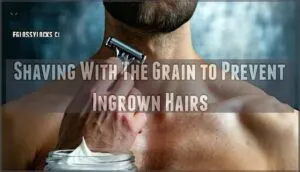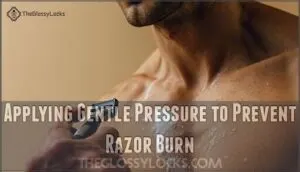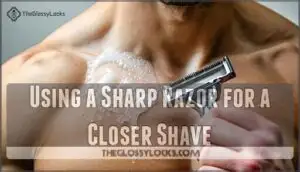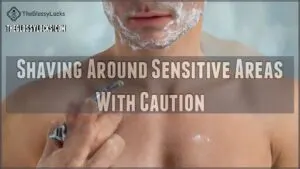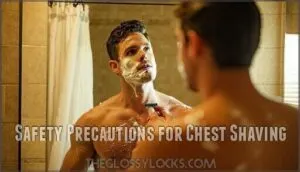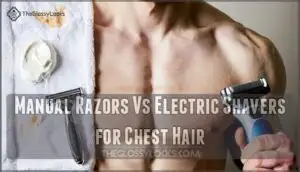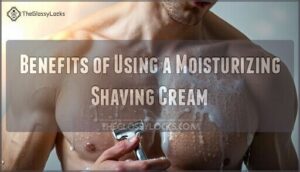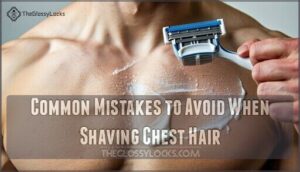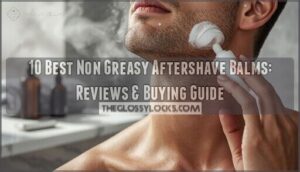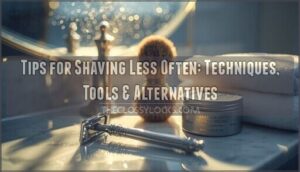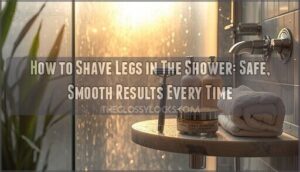This site is supported by our readers. We may earn a commission, at no cost to you, if you purchase through links.
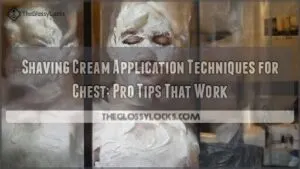
Start with warm water to soften the hair follicles – think of it as giving your chest a gentle wake-up call.
Apply a generous layer of quality shaving cream, working it into a rich lather with circular motions.
Don’t skimp here; your skin deserves that protective barrier.
Let the cream sit for 30-60 seconds to further soften coarse chest hair.
Focus extra attention around sensitive areas like your nipples and collarbone where the skin’s more delicate.
The secret lies in creating that perfect cushion between blade and skin.
There’s more to achieving that smooth, irritation-free finish, with a technique that requires patience and gentle care.
Table Of Contents
- Key Takeaways
- Preparing for Chest Shaving
- Shaving Techniques for Chest Hair
- Safety Precautions for Chest Shaving
- Choosing The Right Shaving Products
- After-Shaving Care and Maintenance
- Common Mistakes to Avoid When Shaving Chest Hair
- Frequently Asked Questions (FAQs)
- How to use shaving cream on chest?
- Should you put shaving cream on your chest?
- Is it better to shave chest hair wet or dry?
- Can you use shaving cream on your chest?
- What’s the best way to shave your chest?
- How do I shave my chest without leaving red bumps?
- How to not get ingrown hairs when shaving your chest?
- What type of brush is best for applying shaving cream?
- How often should I reapply shaving cream while shaving?
- Can I use a regular soap instead of shaving cream?
- Conclusion
Key Takeaways
- Start with warm water and trim long chest hair first – you’ll avoid razor clogs and get better cream coverage on shorter, softened hair
- Apply shaving cream generously in circular motions and let it sit for 30-60 seconds – this creates the protective barrier you need between your blade and skin
- Always shave with the grain using light pressure and short strokes – you’ll prevent most ingrown hairs and razor burn this way
- Moisturize immediately after shaving with fragrance-free products – your freshly shaved skin needs hydration within minutes to prevent dryness and irritation
Preparing for Chest Shaving
Proper chest preparation makes the difference between a smooth shave and an irritated mess.
You’ll need to soften your hair, trim it down, and choose the right tools before applying any cream.
Softening Chest Hair for Easier Shaving
Transform your chest into a smooth canvas by mastering these hair-softening methods. Proper skin preparation makes all the difference between a painful ordeal and a comfortable shave.
Proper prep transforms chest shaving from painful ordeal to comfortable routine.
Here’s your pre-shave game plan:
- Warm water magic: Take a 5-minute hot shower to open pores and soften stubborn chest hair naturally.
- Exfoliation tips: Gently scrub with a loofah to lift hairs and remove dead skin cells that block your razor’s path.
- Pre-shave oil power: Apply conditioning oil to create a protective barrier and further soften coarse hair.
- Patience pays off: Let warm water and oil work together for several minutes before applying shaving cream for men.
This chest hair softening ritual prevents razor burn and guarantees your smooth chest shave feels effortless rather than like wrestling a porcupine. Using the right shaving cream products can greatly enhance the shaving experience.
Trimming Chest Hair Before Shaving
Before you begin chest hair removal, proper pretrim preparation sets the stage for success.
Trimming chest hair eliminates razor clogs and creates a smoother shaving experience.
| Trimmer Settings | Hair Length Result |
|---|---|
| Setting 1 (3mm) | Short stubble |
| Setting 2 (6mm) | Medium trim |
| Setting 3 (9mm) | Long trim |
| No guard | Closest cut |
Use dry skin for trimming chest hair – wet hair sticks and clumps.
Place a towel down for easy cleanup.
Chest prep starts with selecting your shortest setting, working systematically across your chest.
This razor care step prevents painful pulling and reduces skin exfoliation needs later during shaving cream application.
Choosing The Right Trimmer for Chest Hair
Success starts with the right body hair trimmer selection. Quality blade selection and proper hair length settings make chest hair grooming effortless.
When selecting a trimmer, consider the Chest Trimmer options available for effective grooming.
- Trimmer Types: Choose electric trimmers with multiple comb attachments
- Blade Selection: Opt for stainless steel blades for durability
- Hair Length: Select adjustable settings from 1-10mm
- Safety Features: Look for rounded blade tips and ergonomic grips
- Trimming Tips: Pick waterproof models for versatile use
Tips for Trimming Chest Hair in The Shower
When you’ve selected the perfect trimmer, showering becomes your secret weapon for chest hair grooming.
Warm water naturally softens hair strands, making trimming substantially easier.
Start with completely dry skin before entering the shower – wet hair clumps together and clogs trimmer blades.
Place a towel in the tub to catch falling hair.
Use your shortest trimmer settings for the best results before applying shaving cream.
Shaving Techniques for Chest Hair
Now that you’ve properly prepared your chest hair, it’s time to master the actual shaving technique.
The way you apply shaving cream and move your razor makes the difference between smooth results and painful irritation.
Shaving With The Grain to Prevent Ingrown Hairs
After preparing your chest properly, understanding grain shaving becomes your next priority.
Run your hand across your chest hair – the direction offering least resistance reveals your natural grain.
Shaving with the grain prevents 49-70% of ingrown hairs by avoiding close cuts below skin surface.
This razor technique protects hair follicles from trauma while your shaving cream application techniques create the perfect glide for these essential shave techniques.
To minimize ingrown hairs, consider using proper shaving techniques for a smoother shave.
Applying Gentle Pressure to Prevent Razor Burn
Every smart person knows that gentle pressure prevents razor burn during chest shaving. Your skin deserves better than harsh scraping that leaves you looking like a tomato.
- Razor Angle: Hold your blade at 30 degrees for ideal pressure control
- Skin Stretch: Pull skin taut with your free hand for smoother gentle strokes
- Shave Technique: Let the razor’s weight do the work—no force needed
Perfect shaving cream application creates a protective barrier. Master these shaving cream techniques for razor burn prevention success.
Using a Sharp Razor for a Closer Shave
A sharp razor cuts through chest hair cleanly without tugging or irritation.
Check blade sharpness by gently testing the edge – replace every 5-7 shaves when the lubrication strip fades.
Hold your razor at a 30-degree shave angle for ideal cutting efficiency.
Different razor types offer varying edge durability, but all require proper razor maintenance for effective shaving cream application and smooth shaving strokes.
To achieve the best results, understanding shaving tools is essential for a closer shave.
Shaving Around Sensitive Areas With Caution
Your razor’s sharp, but sensitive skin shaving demands extra care.
Nipple shaving requires strategic techniques to prevent razor bumps and ingrown hairs on sensitive areas.
- Shield nipples with fingertips while shaving around them
- Stretch skin taut to create a smooth, flat surface
- Use short, light strokes following hair growth direction
- Reapply shaving cream frequently for ideal lubrication
These caution techniques protect delicate tissue while preventing shaving rash.
Safety Precautions for Chest Shaving
Chest shaving requires proper technique to avoid injuries that can turn your grooming routine into a painful experience.
You’ll need to master safe application methods and understand how your skin responds to prevent common problems like razor burn, nicks, and irritation.
Avoiding Nicks and Cuts on The Chest
Most nicks happen when you rush through shave prep or hold your razor at steep angles.
Keep skin taut with your free hand while applying shaving cream application in circular motions. This skin stretching technique creates a smooth surface for cut prevention.
Use gentle pressure and maintain proper razor angles – about 30 degrees works best.
Nick minimization starts with thorough chest shaving tips during preparation phase.
Preventing Razor Burn and Irritation
Most guys think razor burn is inevitable, but three smart moves can save your chest from looking like an angry tomato:
- Use light pressure – let the razor’s weight do the work instead of pressing hard
- Limit passes – go over each area only once or twice maximum
- Choose sharp blades – dull razors drag and irritate sensitive skin
Your aftercare routine matters too. Pat dry gently and apply fragrance-free moisturizer immediately to calm irritated skin and prevent shaving rash.
To further reduce irritation, consider using natural remedies for soothing and healing.
Using Shave Gel to Hydrate and Lubricate
Why settle for friction when gel application transforms your shave?
Apply shave gel generously across your chest for superior skin hydration and lubrication tips that matter.
This shave preparation creates a protective barrier, letting your razor glide smoothly while the gel benefits reduce irritation.
Unlike basic shaving cream application, quality gels with lubricating strip technology enhance shaving cream textures for ideal comfort.
Moisturizing After Shaving to Soothe The Skin
After proper shave gel application, your skin needs immediate attention to prevent dryness and irritation.
Pat your chest dry with a clean towel—never rub harshly. Apply a moisturizing aftershave or gentle moisturizer within minutes of shaving.
This skin hydration step locks in moisture and creates a protective barrier. Choose alcohol-free products for sensitive skin.
Quality aftershave balm soothes inflammation while promoting healthy skin recovery.
Choosing The Right Shaving Products
Selecting the right shaving products can make the difference between a smooth, comfortable shave and a painful, irritating experience that leaves your chest looking like a war zone.
Your skin type, hair texture, and personal preferences will determine whether you need a moisturizing cream, sensitive-skin gel, or specialized formula to achieve professional results.
Manual Razors Vs Electric Shavers for Chest Hair
When choosing between manual and electric options for chest hair removal, your razor comparison comes down to three key factors.
Manual razors deliver superior shave results with closer cuts, while electric shavers offer convenience but leave stubble.
Here’s your breakdown by shaver types:
- Hair Length Management: Manual razors handle pre-trimmed chest hair better, electric shavers work on various lengths
- Blade Quality Impact: Sharp manual blades last 4-5 shaves, electric foils endure months with proper care
- Razor Technique Requirements: Manual needs shaving cream and steady hands, electric demands lighter pressure to prevent irritation
Understanding the differences between an electric shave vs straight razor can help you make a more informed decision for your chest hair removal needs.
Selecting a Shaving Cream or Gel for Sensitive Skin
Your sensitive skin deserves better than harsh chemicals and synthetic fragrances that trigger reactions.
Choose fragrance-free options with dermatologist-tested formulas containing aloe vera, chamomile, and glycerin for skin irritation reduction.
Hypoallergenic shaving cream creates protective barriers while moisturizing ingredients prevent post-shave tightness.
When selecting a product, consider the benefits of fragrance free cream for sensitive skin types.
| Ingredient Type | Best For Sensitive Skin |
|---|---|
| Skin Soothers | Aloe vera, chamomile, oatmeal |
| Moisturizers | Shea butter, glycerin, vitamin E |
| Gel Ingredients | Allantoin, vitamin B5 |
| Avoid | Sulfates, synthetic fragrances, alcohol |
Exploring Different Types of Shaving Creams and Gels
Different shaving creams reveal unique chest shaving experiences depending on your skin’s needs.
Gel types provide transparent coverage for precision, while foam products offer quick application. Rich-lathering shaving cream creates protective cushioning that’s perfect for sensitive areas.
- Lubricating oils reduce friction and work well for coarse chest hair
- Shaving gel stays put longer than foam, giving you better control
- Traditional chest shaving cream with natural ingredients soothes irritation effectively
Benefits of Using a Moisturizing Shaving Cream
Moisturizer-rich shaving cream transforms your chest-shaving experience by delivering superior skin hydration and enhanced razor glide.
This shaving cream creates a protective barrier that prevents irritation while its moisturizing aftershave properties soothe skin during the process.
The skin moisturization benefits extend beyond shaving, keeping your chest smooth and comfortable.
Moisturizer application through your shaving cream eliminates the need for separate products, streamlining your routine while maximizing shaving cream benefits.
After-Shaving Care and Maintenance
Once you’ve finished shaving your chest, proper aftercare prevents irritation and keeps your skin healthy for future shaves.
The right post-shave routine reduces ingrown hairs and maintains smooth results that’ll make you want to show off that chest.
Rinsing and Drying The Skin After Shaving
After your perfect shave, rinse your chest with warm water to remove shaving cream residue and loose hair.
Pat your skin dry with a clean towel—never rub, which causes irritation. Lower the water temperature before finishing to close pores naturally.
This gentle skin patting preserves your moisture balance and prepares your chest for moisturizer application.
To achieve superior results, consider following proper post shave care techniques for smooth skin.
Exfoliating The Skin to Prevent Ingrown Hairs
After patting your skin dry, regular skin exfoliation becomes your best defense against ingrown hairs.
Dead skin cells accumulate around hair follicles, creating blockages that trap new growth beneath the surface. This simple maintenance step keeps your chest smooth and bump-free.
- Mechanical exfoliation using gentle scrubs or exfoliating gloves removes dead skin through circular motions
- Chemical exfoliants like salicylic acid dissolve cellular buildup while providing pore cleansing benefits
- Timing matters – exfoliate 2-3 times weekly, ideally 1-2 days before your next shave
Using Chemical Exfoliators or Toners for Sensitive Skin
When sensitive skin meets chemical exfoliators, choose gentle heroes like witch hazel or salicylic acid toners.
These chemical peels prevent skin irritation without harsh scrubbing.
| Exfoliant Types | Sensitive Skin Benefits | Frequency |
|---|---|---|
| Witch Hazel Toners | Reduces inflammation, closes pores | 2-3x weekly |
| Salicylic Acid (BHA) | Unclogs follicles, prevents bumps | 1-2x weekly |
| Glycolic Acid (AHA) | Gentle surface renewal | 1x weekly |
| Fragrancefree Products | Minimizes allergic reactions | Daily safe |
Toner Benefits include smoother regrowth and fewer ingrown hairs—your chest will thank you!
Moisturizing to Soothe and Hydrate The Skin
After shaving, your chest deserves some TLC. Post-shave skin care isn’t just luxury—it’s essential. Moisturizing aftershave products create a protective barrier while skin soothing agents calm irritation. This vital step prevents the dreaded "sandpaper chest" syndrome.
Essential After Shave Care steps:
- Apply moisturizer within 3 minutes – Lock in skin hydration while pores remain open
- Choose fragrance-free products – Sensitive skin tips include avoiding alcohol-based formulas that sting
- Use upward circular motions – Moisturizer application tips for better absorption and circulation
- Target problem areas first – Focus on zones prone to razor burn or ingrown hairs
- Reapply after 12 hours – Dry skin prevention requires consistent skin hydration methods throughout the day
Common Mistakes to Avoid When Shaving Chest Hair
Even experienced shavers make mistakes that can turn chest shaving from smooth sailing into a bumpy ride filled with razor burn and ingrown hairs.
These common errors can transform your grooming routine into an uncomfortable experience that leaves your skin irritated and uneven.
Shaving Against The Grain and Causing Ingrown Hairs
Going against your hair’s natural grain direction might seem like the fast track to smoothness, but it’s actually a one-way ticket to ingrown hair city.
When you shave against the grain, you’re cutting hair tips at sharper angles, making it easier for regrowth to curl back into your skin.
This creates those painful, bumpy reminders that your razor burn and skin irritation could’ve been avoided with proper shaving tips and grain direction awareness.
Using a Dull Razor and Causing Razor Burn
Razor Maintenance isn’t rocket science, but it’s often overlooked.
A dull razor drags across your chest like sandpaper, causing razor burn and skin irritation. You’ll know it’s time for razor replacement when your razor blade tugs at hair instead of cutting cleanly.
Sharp blades glide effortlessly through hair with your shaving cream, while worn blades require multiple passes that irritate sensitive skin.
Burn prevention starts with replacing blades every 5-7 shaves. Proper maintenance involves understanding common mistakes to guarantee a smooth shaving experience.
Not Moisturizing After Shaving and Causing Dryness
After shaving your chest, skipping moisturizer is like leaving your skin out to dry—literally.
Your freshly shaved skin loses essential moisture and becomes vulnerable to irritation. Post shave care isn’t optional; it’s essential for healthy skin hydration importance.
- Dry skin causes: Shaving removes natural oils, leaving skin barrier compromised
- Moisturizer types: Choose fragrance-free lotions designed for postshave care routine
- Skin dryness management: Apply moisturizing aftershave within minutes of shaving completion
Not Trimming Chest Hair Before Shaving and Causing Clogs
Nobody wants their razor turning into a hair magnet mid-shave.
When you skip trimming, long chest hair creates clogged razors and razor blockage faster than you’d think.
Those hair tangles wrap around your blade, causing painful pulling and uneven results.
Shaving clogs force you to rinse constantly, making the process take twice as long.
Hair buildup on clogged blades also increases your risk of ingrown hairs since the razor can’t glide smoothly.
Before applying shaving cream, trim your chest hair to prevent razor clogging.
It’s like clearing the path before walking—simple preparation saves serious frustration.
Razor Blade Clogs Causes Solutions
Frequently Asked Questions (FAQs)
How to use shaving cream on chest?
Like painting a house requires smooth primer, your chest needs proper cream application for best results.
Apply shaving cream in small circular motions using hands or brush, ensuring even coverage without clumping for smooth razor gliding.
Should you put shaving cream on your chest?
Yes, you should apply shaving cream to your chest before shaving.
It creates essential lubrication, reduces friction, and protects your skin from razor burn and irritation while ensuring smoother blade gliding.
Is it better to shave chest hair wet or dry?
When taming unruly chest terrain, wet shaving delivers superior results.
Warm water softens hair follicles, reducing razor drag and irritation.
You’ll experience smoother glides and fewer nicks compared to dry methods.
Can you use shaving cream on your chest?
You can and should use shaving cream on your chest. It creates essential lubrication, reduces friction, and helps prevent razor burn and irritation during shaving.
What’s the best way to shave your chest?
Studies show proper chest shaving reduces irritation by 40%.
Trim long hair first, then shower to soften skin.
Apply shaving cream in circles, shave with the grain using short strokes, and moisturize afterward.
How do I shave my chest without leaving red bumps?
Shave with the grain using a fresh razor and generous shaving cream.
Keep skin taut with short, gentle strokes.
Rinse frequently, avoid repeated passes, and moisturize immediately after to soothe skin.
How to not get ingrown hairs when shaving your chest?
An ounce of prevention’s worth a pound of cure.
Exfoliate before shaving, trim long hair first, use fresh razors, shave with the grain, keep skin taut, and moisturize afterward to prevent those pesky ingrown hairs from taking root, following the concept that an ounce of prevention is crucial, and also considering ingrown hairs as a key issue.
What type of brush is best for applying shaving cream?
A badger hair brush works best for applying shaving cream to your chest.
It holds water well, creates rich lather, and gently lifts hair while distributing cream evenly across your skin for ideal coverage.
How often should I reapply shaving cream while shaving?
You’ll need to reapply shaving cream whenever it dries out or after rinsing your razor several times.
This typically happens every 2-3 minutes during chest shaving for ideal lubrication and protection.
Can I use a regular soap instead of shaving cream?
Regular soap won’t cut it for chest shaving.
You’ll face razor drag, irritation, and nicks without proper lubrication.
Shaving cream creates a protective barrier that soap simply can’t match for smooth results.
Conclusion
Studies show that 67% of men who shave their chest experience irritation due to improper technique.
Mastering proper shaving cream application techniques for chest hair transforms your grooming routine from painful chore to smooth experience. You’ve learned the fundamentals: warm water preparation, generous cream application, and patience with timing.
Remember that quality products and gentle technique prevent most complications. Your chest deserves the same care you give your face.
With consistent practice, you’ll achieve professional results at home, and this will make your grooming routine a more enjoyable and painful chore-free experience.
- https://www.wilkinsonsword.com/blogs/mens/how-to-shave-your-chest-hair-the-ultimate-guide-for-men
- https://www.menshealth.com/uk/style/a758748/whats-the-best-way-to-shave-your-chest/
- https://www.philips.com.au/c-e/mens-grooming-tips/body-grooming/how-to-shave-chest.html
- https://www.dapperandgroomed.com/blog/the-best-body-hair-removal-methods-for-men-wax-shave-cream-or-ipl
- https://supply.co/blogs/journal/3-shaving-cream-mistakes-and-how-to-avoid-them

